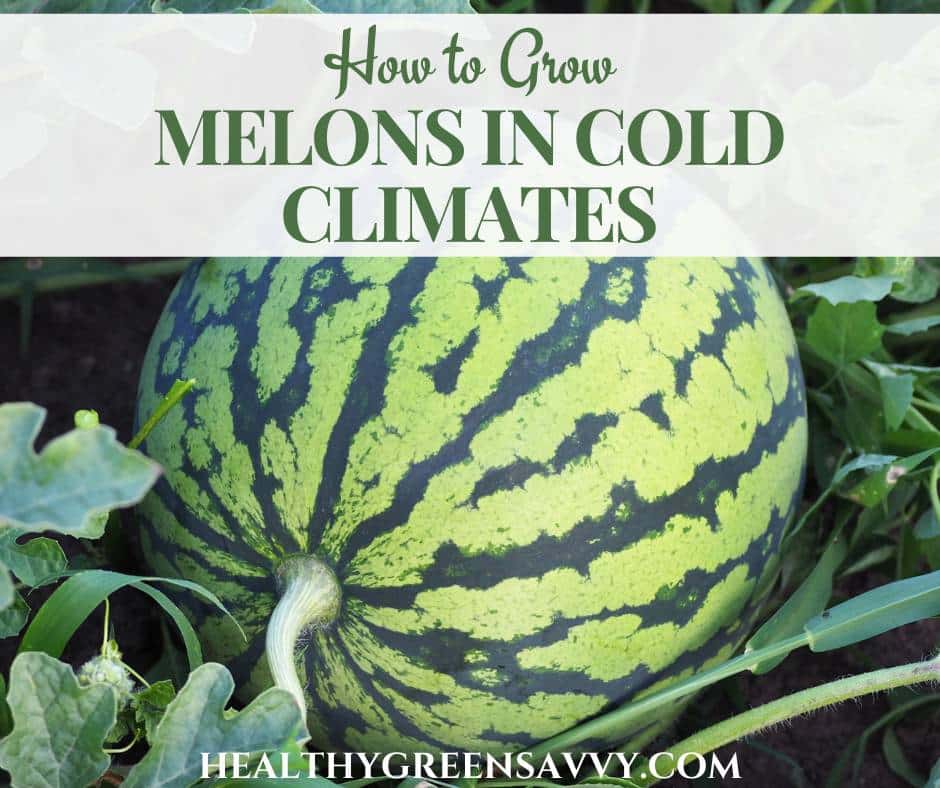Last Updated on March 20, 2025
Trying to grow melons in cold climates? Here’s what northern gardeners need to know to successfully grow melons in a cooler growing zone.

CAN YOU GROW MELONS IN COOL CLIMATES?
Even the most talented gardeners have likely experienced frustration trying to grow some of those sweetest fruits of summer, melons. Though your peas, cucumbers, and squash may flourish, you may have had difficulties getting good watermelons and cantaloupes from your garden.
I sure have. We’ve tried “baby” watermelons, Minnesota Midget cantaloupes, and other small melons in an effort to enjoy some homegrown summer fruit. I’ve managed tomatoes, cukes, and plentiful zucchini in my small but not terribly sunny suburban yard, but have had little success with melons. Hope continues to triumph over experience, and I plant a few melon seeds most years just for kicks. I don’t expect much, but I try just to see if some stroke of luck might bring me a fruit or two. Some years I’ve gotten a couple tiny melons that don’t make it all the way to ripeness and wind up in the compost.
Hope often triumphs over experience, and I plant a few melon seeds most years just for kicks. I don’t expect much, but I try just to see if some stroke of luck might bring me a fruit or two. Some years I’ve gotten a couple adorably tiny melons that don’t make it all the way to ripeness and wind up in the compost.
But every single summer we get big, flavorful melons from our CSA and at our local farmers’ markets, so I knew growing great — even full-size — melons is possible, even in the short growing season we have here in Minnesota. It was time to do some research.
Two all-important words for gardeners wanting to grow their own melons: FULL SUN.
There are some other strategies for successful melon growing as well, but if your garden doesn’t get full sun, you may be out of luck.
Here are a bunch of vegetables that grow in shade to try instead if your garden isn’t especially blessed with sunlight.
My yard gets part sun at best, so we’ll continue to buy melons from local growers. But if you’re a lucky gardener with plentiful sunshine, growing sweet, delicious melons is totally doable and will be more likely to succeed with these tips from the pros.
HOW TO GROW MELONS IN COLD CLIMATES
If you’re keen to try growing melons in a cooler climate, there are some fundamentals you need. The first and absolutely necessary element is a full sun location. The other pointers below can help, but only if you also have full sun.
1. TWO MOST IMPORTANT WORDS: FULL SUN
Cantaloupes, watermelons, and other types of melon need a lot of sun, and the six to seven hours I get in the sunniest part of my yard just don’t cut it. “You need a minimum of ten hours,” Vince Fritz, Professor of Horticultural Science and Director of the North Central Research and Outreach Center, told me.
*Sigh.*
On a visit to a nearby community garden, I found melons booming along quite happily in a large open field. Those melons were easily getting more than twelve hours of sun per day. One of the proud owners of numerous gorgeous fruits was a novice gardener who purchased Minnesota Midget cantaloupe and Sugar Baby watermelon plant starts from a local nursery and planted them at her new community garden plot in early summer.

By mid August, she and her husband were enjoying the first of 16 melons from their single cantaloupe vine. They also got several juicy watermelons. I had some serious garden envy!
If you’ve got full sun but still struggle to get good melons, the tips below should help your vines become more productive and your melons ripen to perfect sweetness.
2. CHOOSE SHORT SEASON VARIETIES
Our short growing season means you want your melons to reach maturity as early as possible, ideally in fewer than 90 days. Fortunately, there are plenty of short-season melons to choose from, including some varieties that mature in only 65 days. ‘Minnesota Midget’ was bred especially for the challenges of our climate and are a good choice for the home gardener.
I spoke to local growers about their melon preferences, and several praised ‘Athena’ cantaloupes (75 days) as a winner for reliability, size, and flavor. One grower preferred ‘Atlantis’ (74 days) as a more consistent performer than ‘Athena.’
For smaller watermelons, recommendations included ‘Pata Negra’ and ‘Peace,’ a yellow variety. Our CSA farm has had great success with the large heirloom ‘Crimson,’ which matures in only 80 days and produces huge, flavorful watermelons.
Varieties to consider:
Cantaloupe — ‘Athena,’ ‘Atlantis,’ ‘Minnesota Midget,’ ‘Jenny Lind’
Watermelon — ‘Blacktail Mountain,’ ‘Crimson,’ ‘New Orchid,’ ‘Peace,’ ‘Pata Negra,’ ‘Sweet Siberian,’ ‘Sugar Baby,’ ‘Sunshine’
Honeydew, crenshaw & novelty melons — ‘Tigger,’ ‘Lilly’, ‘Galia’
3. WARM YOUR SOIL
To give your heat-loving melon plants a head start, most experts recommend warming soil by covering it with black plastic. Fritz recommends growing melons in raised beds covered with black plastic to warm the soil even more effectively. The superior drainage of raised beds, he says, “makes heat transfer more effective.” He suggests stretching the plastic over the bed at the warmest part of the day to help ensure that it’s taut against the soil, which will improve heat transfer further.
If you’d rather not use plastic mulch, using raised beds or mounding soil can help increase soil temperatures, but soil will not warm as quickly. Another option to consider is a large pot, though most of those are also made of plastic. Another advantage is that you might be able to move it around to help get your melon plant more hours of sun.
Floating row covers can hold heat while protecting plants from pests like squash vine borers and cucumber beetles, which can ruin your crop. Just remember to remove the covers when flowers begin to form so the bees can pollinate them.

TRANSPLANT OR DIRECT SEED?
If you’ve chosen a short-season variety, you may try direct seeding a week before the last frost, when the soil has had a chance to warm to at least 65 degrees, or you risk issues with rot or poor germination. Use a soil thermometer to check the temperature before planting.
However, Fritz strongly favors using transplants rather than direct seeding to give your melon vines a better chance to produce for you in our short season.
He cautions gardeners to take particular care with the hardening off process. “It’s really essential that hardening is done correctly,” he says, in order to protect melon plants from drought stress.
Melon roots don’t want to be disturbed, so it’s best to use a biodegradable pot that you can plant without removing delicate seedlings.
ADDITIONAL TIPS FOR SUCCESSFUL MELON GROWING
OPTIMIZE SOIL
Melons prefer well-drained soil with a pH of 6.0-6.5; below 6.0 you’ll have trouble with fruit set.
Insufficient nutrients and water stress can keep your melons from developing the rich sweetness that’s the reason we grow them in the first place. Work in plenty of compost and side dress with a balanced fertilizer. Be careful not to overdo the nitrogen, warns Fritz, or you’ll wind up with too much foliage and very little fruit.
WATER REGULARLY
Water deeply, about two inches per week, reducing water to one inch as fruits ripen. Too much water near harvest time makes for a less flavorful melon and may cause fruit to split.
Consider getting a drip irrigation system or use a soaker hose for consistent watering that gets water to the roots, where it’s needed.
KEEP FOLIAGE DRY AND LET AIR CIRCULATE
Fritz suggests watering with a soaker hose or drip tape to get water to the roots and keep the foliage as dry as possible. Melon vines are especially susceptible to powdery and downy mildew, which can, he says, “really hurt your yield potential.”
He also urges gardeners to give melon vines plenty of space in the garden to promote good air circulation and prevent the diseases that can come with too much moisture on the foliage.
Note that if you choose to grow your melons vertically, you should take extra care with watering, as climbing leaves will be more prone to moisture loss.
HELP MELONS RIPEN
Cover the vines to keep them as warm as possible when the weather cools at the end of the season so every melon has a chance to reach maturity.
Toward the end of summer (roughly 6 weeks before your first frost date), it’s best to pinch off flowers that won’t have a chance to ripen in the cooler end-of-season temperatures so the plant can put all its energy into ripening the melons already on the vine.
Melons are prone to rot when in contact with the soil, so lay ripening melons on flat pieces of stone or lids from yogurt containers to keep your fruits off the ground.
How to tell when your melons are ripe:
Cantaloupes: The rind beneath the netting should no longer be green, and the melon should come off the vine easily. Get your melon to the fridge when you smell its telltale aroma, or it will quickly get overripe.
Watermelons and honeydews: Tendrils near the ripe melon will start to brown, and the spot where it lay on the ground should turn from white to yellow.
Making the extra effort to coddle your melon vines will mean you can enjoy these fabulous fruits of summer, even in cold climates.
Armed with these tips, I hope you’ll be gorging yourself on luscious melons next season.
Have you had success growing melons in a cooler climate? Please leave a comment with your best tips!
Check out more of our helpful growing guides:
- How to Grow Rhubarb
- Permaculture Gardening for Beginners
- How to Grow Spinach
- 9 Ways to Grow Food in a Small Garden
- How to Grow Lavender from Seed
- How to Grow Garlic
Save this info on growing melons in cold climates for later!

A version of this article appeared in the March/April 2019 issue of Northern Gardener magazine.

Susannah is a proud garden geek and energy nerd who loves healthy food and natural remedies. Her work has appeared in Mother Earth Living, Ensia, Northern Gardener, Sierra, and on numerous websites. Her first book, Everything Elderberry, released in September 2020 and has been a #1 new release in holistic medicine, naturopathy, herb gardening, and other categories. Find out more and grab your copy here.




 Hi, I'm Susannah, a garden geek, energy nerd, and fan of healthy food and natural remedies. Need some simple, practical solutions for living healthier and greener? You've come to the right place! More about me and my green projects
Hi, I'm Susannah, a garden geek, energy nerd, and fan of healthy food and natural remedies. Need some simple, practical solutions for living healthier and greener? You've come to the right place! More about me and my green projects
Leave a Reply